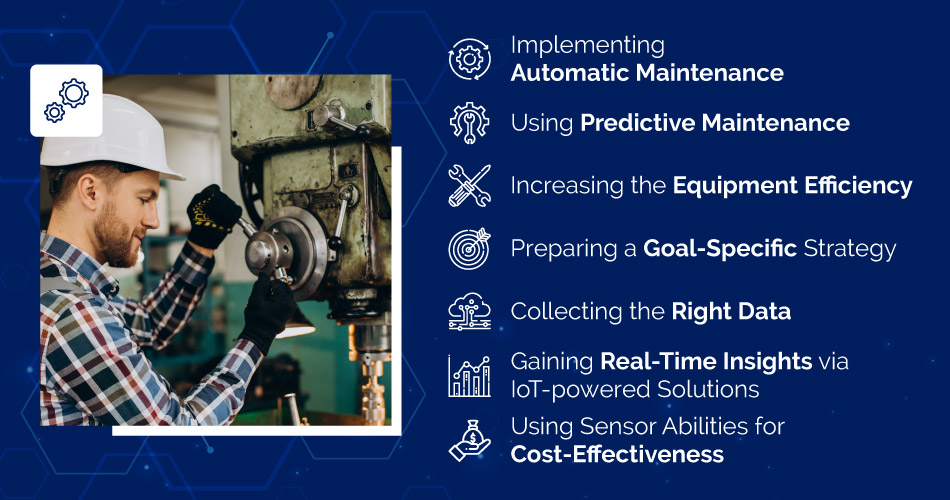Almost every industry includes huge amounts of equipment and pieces of machinery to upgrade their production quality. However, manual checks and regular monitoring are likely to produce errors and unexpected downtime. IoT technology provides seamless processing of the entire plant via automation to avoid such situations and bring better clarity among industrial decisions.
It is estimated that almost 72% of the companies prioritise achieving zero unplanned downtime within their factories. However, the rest of the percentage is simply unaware of their equipment needs, which is likely to create the chances of machine breakdowns at a larger level. So, to avoid such situations that would result in production delays and unimaginable costs, industries like manufacturing, fleeting, water, or energy are opting for IoT technology. Let’s see why!

1) Implementing Automatic Maintenance
Autonomous maintenance ensures that the equipment is properly cleaned and in a ready-to-use condition. It plays a vital role in keeping track of the small details within the industrial zones, especially equipment repair. Using advanced techniques to keep track of the minutest details and critical failures provide the industrialists with in-depth knowledge about the machines and industrial assets. Such techniques also help the managers notice the issues before any critical failure occurs. The inclusion of smart IoT concepts like automation for machine maintenance improves employee engagement and the overall safety of the premises, providing better results.
2) Using Predictive Maintenance
Huge machines will likely face frequent downtimes if not catered to regular checks. It is a mandatory approach to fix scheduled monitoring for such machinery to obtain larger benefits; otherwise, it might cause production delays or quality degradation issues. Therefore, with the help of IoT-powered solutions, businessmen are acquiring real-time monitoring facilities that connect their smart gadgets and industrial equipment, providing actionable insights to predict the best results. IoT provides predictive maintenance that uses insights from the extracted data to draw accurate conclusions. It generates relevant data in a user-readable format, which assists the managers to increase the efficiency of their industries.
3) Increasing the Equipment Efficiency
The Internet of Things is a varied concept that provides asset data for effective business growth. The data-driven approach thus minimizes the overall equipment efficiency loss by making the asset visible in any health condition through an interconnected gadget. It helps the industrialists consistently monitor the existing loopholes and provide the managers with detailed reports for better analysis. The IoT-powered Machine downtime tracking system encompass all the possibilities of procuring actionable insights to identify major productivity losses like equipment stop times loss in speed and quality. This helps the managers take counteractive measures to curb unplanned industrial downtime and save production delays wherever required.
4) Preparing a Goal-specific Strategy
Having goals, even in industries, gives direction to the authorities to keep track of the production between the shifts, operators, and equipment. It streamlines the processes by specifying every detail and setting the accountability for incentive programs. Moreover, setting goal-specific strategies creates value for businesses with proper staff evaluations. This enables a systematic procedure for the staff to carry out process runs without encountering any errors. The industrial goal-specific strategy also helps identify the retraining requirements or training gaps for the staff members to improve their skills according to the business wants. Overall, having goals and accurate data enhances communication across different channels, increasing the business potential and gaining greater profits.
5) Collecting the Right Data
Be it water, power, manufacturing, or fleet, these industries seek the right data to allow the managers to make effective decisions. Therefore, it requires the right data collection for processing quality industrial work. IoT-enabled solutions provide accurate data extraction from the assets that prove to be a great resource for the industrialists to manage the production floor, minimizing the chances of machine downtime. Also, the technology enables historical data management, which allows functioning at different levels like identifying the loopholes, predicting the downtime, and making decisions according to the insights. Therefore, the right data collection through IoT systems ensures better possibilities for the machines to work seamlessly and awaring the managers much before the downtime.
6) Gaining Real-time Insights via IoT-powered Solutions
IoT technology is a data-driven concept that uses sensor devices to gain real-time insights from the industry. These insights reflect the overall scenario of the factory and empower the businesses to excel through reduced machine breakdowns. The real-time insights on each industrial equipment provide the industrialists with regular schedules in the form of illustrative reports, enabling quick analysis for better results. IoT-powered machine monitoring solutions are designed to keep a real-time check upon the machine conditions of the factories and ensure that the industrialists work with accurate results. Also, instant triggering on the interconnected devices establishes a regular inspection schedule for vitally-important machines so that they operate at their best.
7) Using Sensor Abilities for Cost-effectiveness
Unplanned downtime in industry costs more than $100,000, along with the delay in production. For instance, if a company produces 100 units per minute, which in turn gives a profit of $1 per unit. The cost of unplanned downtime would calculate around $100 per minute or $6000 an hour. It, thus, creates a massive impact on the company ratings and downgrades the brand image on a deeper level. Installing an IoT-powered machine monitoring solution that uses sensor abilities to extract data and visualize the industrial details for effective production help reduce the cost of unplanned downtime by significant numbers.











